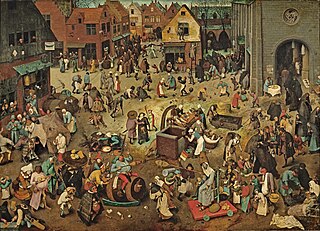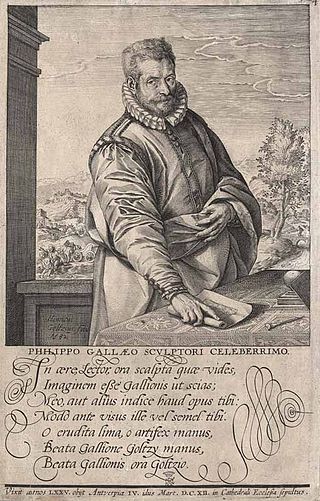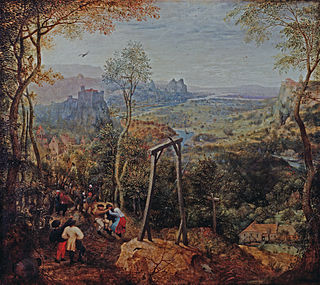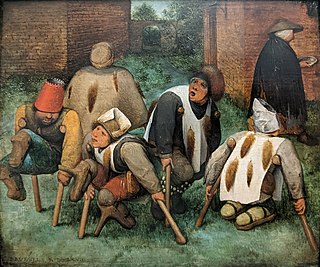
Pieter Bruegelthe Elder was among the most significant artists of Dutch and Flemish Renaissance painting, a painter and printmaker, known for his landscapes and peasant scenes ; he was a pioneer in presenting both types of subject as large paintings.

The Fight Between Carnival and Lent is an oil-on-panel painting executed by the Dutch and Flemish Renaissance painter Pieter Bruegel the Elder in 1559. It is a panorama of contemporary life in the Southern Netherlands. While the painting contains nearly 200 characters, it is unified under the theme of the transition from Shrove Tuesday to Lent, the period forty days before Easter.

PhilipGalle was a Dutch publisher, best known for publishing old master prints, which he also produced as designer and engraver. He is especially known for his reproductive engravings of paintings.

The Magpie on the Gallows is a 1568 oil-on-wood panel painting by the Netherlandish Renaissance artist Pieter Bruegel the Elder. It is now in the Hessisches Landesmuseum, in Darmstadt.

Netherlandish Proverbs is a 1559 oil-on-oak-panel painting by Pieter Bruegel the Elder that depicts a scene in which humans and, to a lesser extent, animals and objects, offer literal illustrations of Dutch-language proverbs and idioms.

The Hunters in the Snow, also known as The Return of the Hunters, is a 1565 oil-on-wood painting by Pieter Bruegel the Elder. The Northern Renaissance work is one of a series of works, five of which still survive, that depict different times of the year. The painting is in the collection of the Kunsthistorisches Museum in Vienna, Austria. This scene is set in the depths of winter during December/January.

The Blind Leading the Blind, Blind, or The Parable of the Blind is a painting by the Netherlandish Renaissance artist Pieter Bruegel the Elder, completed in 1568. Executed in distemper on linen canvas, it measures 86 cm × 154 cm. It depicts the Biblical parable of the blind leading the blind from the Gospel of Matthew 15:14, and is in the collection of the Museo di Capodimonte in Naples, Italy.

Christ and the Woman Taken in Adultery is a small panel painting in grisaille by the Netherlandish Renaissance printmaker and painter Pieter Bruegel the Elder. It is signed and dated 1565.

Het Luilekkerland — known in English as The Land of Cockaigne — is a 1567 oil painting by Pieter Bruegel the Elder. In medieval times, Cockaigne was a mythical land of plenty, but Bruegel's depiction of Cockaigne and its residents is not meant to be a flattering one. He chooses rather a comic illustration of the spiritual emptiness believed to derive from gluttony and sloth, two of the seven deadly sins.

Peeter Baltens, Pieter Balten or Pieter Custodis, was a Flemish Renaissance painter, draughtsman, engraver and publisher. Baltens was also active as an art dealer and poet. He was known for his genre paintings, religious compositions and landscapes.

The Beggars or The Cripples is an oil-on-panel by the Netherlandish Renaissance artist Pieter Bruegel the Elder, painted in 1568. It is now in the Louvre, in Paris. Its also is the only painting by Bruegel in the Louvre, received as a gift in 1892.

The Peasant and the Nest Robber is an oil-on-panel painting by the Netherlandish Renaissance artist Pieter Bruegel the Elder, painted in 1568. It is in the Kunsthistorisches Museum in Vienna.

The Fall of the Rebel Angels is an oil-on-panel painting of 1562 by the Netherlandish Renaissance artist Pieter Bruegel the Elder. The painting is 117cm x 162cm and is now in the Oldmasters Museum in Brussels, Belgium. The Fall of Rebel Angels depicts Lucifer along with the other fallen angels that have been banished from heaven. Angels are falling from the sun in a stacked manner along with ungodly creatures that Bruegel created.

The Census at Bethlehem is an oil-on-panel painting by the Flemish Renaissance artist Pieter Bruegel the Elder, painted in 1566. It is signed and measures about 1155 × 1645 mm. It is now in the Oldmasters Museum in Brussels, which acquired it in 1902.

The Suicide of Saul is an oil-on-panel painting by the Flemish Renaissance artist Pieter Bruegel the Elder, painted in 1562. It is in the collection of the Kunsthistorisches Museum, in Vienna.

Pieter van der Heyden was a Flemish printmaker who is known for his reproductive engravings after works by leading Flemish painters and designers of the 16th century.

Nicolaes Jonghelinck (1517–1570) was a merchant banker and art collector from Antwerp. He is best known for his collection of paintings by Pieter Bruegel the Elder and Frans Floris. His brother was the sculptor Jacques Jonghelinck.

The Adoration of the Magi in the Snow is a painting in oils on oak panel of 1563, by Pieter Bruegel the Elder, now in the Oskar Reinhart Collection Am Römerholz in Winterthur, Switzerland. With two Italian exceptions, it is thought to be the first depiction of falling snow in a Western painting, the snowflakes boldly shown by dots of white across the whole scene, added when the work was otherwise completed.

Winter Landscape with a Bird Trap, also known as The Bird Trap, is a panel painting in oils by the Flemish painter Pieter Bruegel the Elder, from 1565, now in the Oldmasters Museum in Brussels. It shows a village scene where people skate on a frozen river, while on the right among trees and bushes, birds gather around a bird trap. It is signed and dated at the lower right: "BRVEGEL / M.D.LXV’1". There are more early copies of this than any other painting by Pieter Bruegel the Elder, many by his much younger son Pieter Brueghel the Younger, or other members of the Brueghel family dynasty and workshop. The art historian Klaus Ertz documented 127 copies in his comprehensive monograph on the artist's son in 2000.

Naval Battle in the Gulf of Naples is an oil painting on panel by the Flemish Renaissance artist Pieter Bruegel the Elder, painted from 1558 to 1562. It is in the Doria Pamphilj Gallery in Rome.






















